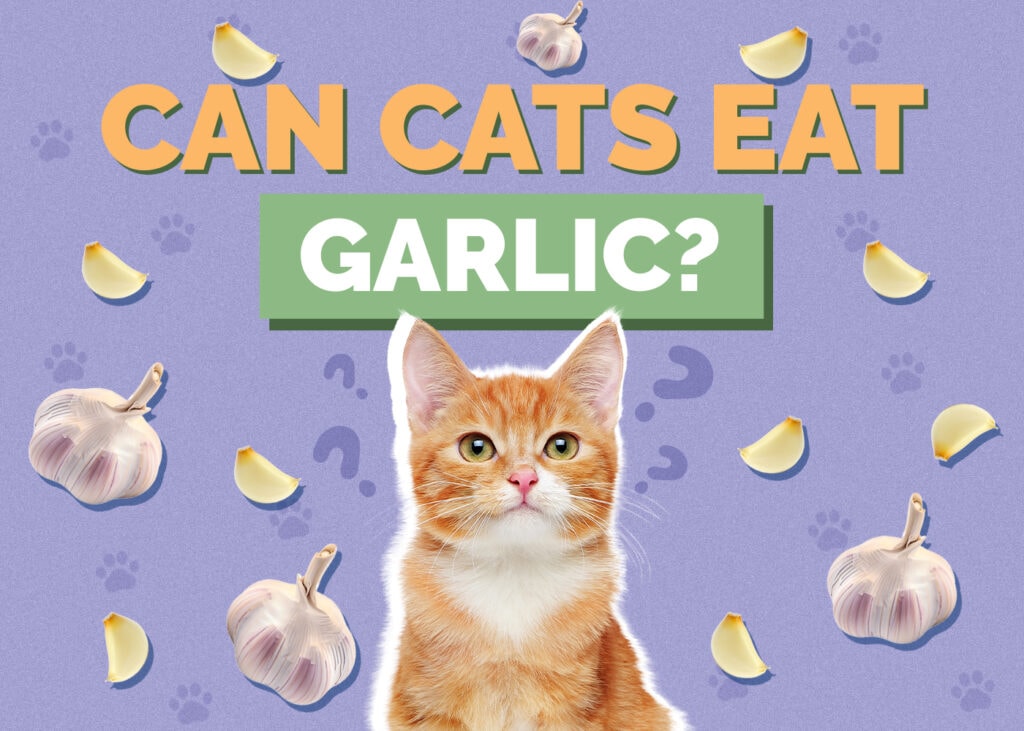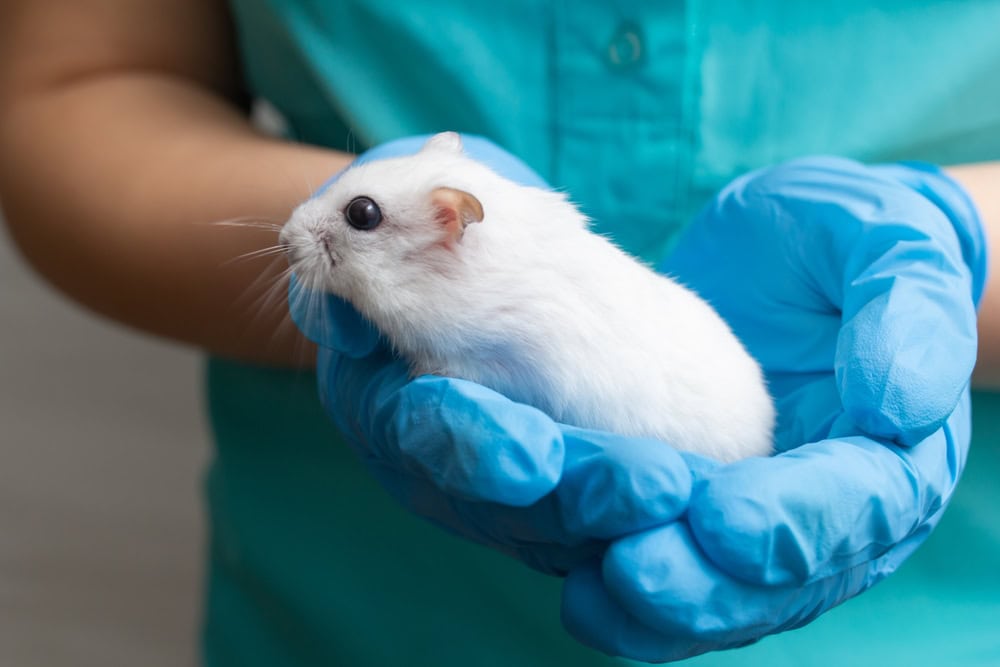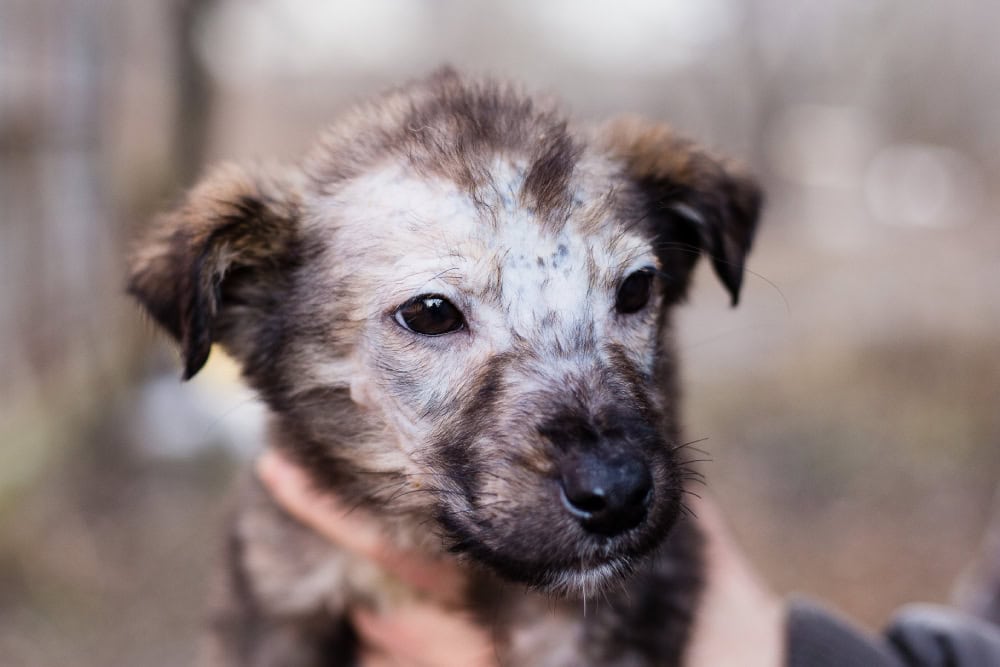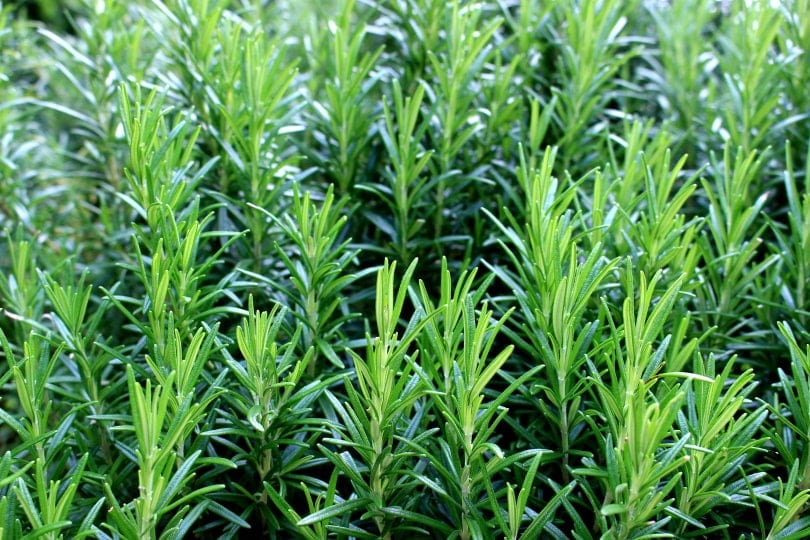George Farmer’s tanks are worthy of the many awards he wins every year. Ever wonder what makes his tanks so beautiful? He follows the four principles of Aquascaping. If you familiarize yourself with these principles and apply them to your tanks, you’ll quickly begin to see those ideas in your head turn into aquascapes that attract attention (we recommend these aquascape tools).
Our guide will fine-tune your Aquascape Addition into effortless art. Let’s start with the most crucial principle: the Rule of Thirds. (Don’t skip this; it’s important so you know how to set up an aquascape.)

The Rule of Thirds: Aquascape Design Layout
For some reason, the human eye is attracted to objects divided into a grid, and placing items on lines created by this grid nearly always makes a balanced, visually attractive layout. The same is true of Aquascaping.
Let’s look at a sample layout, which is an excellent example of how to aquascape!
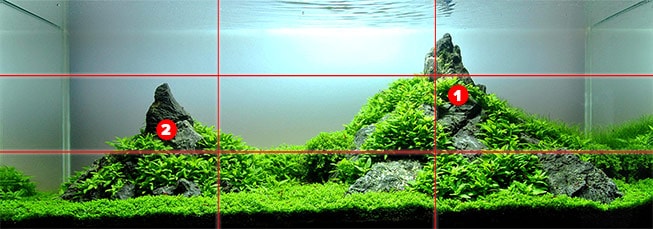
Two things are immediately apparent: this designer is good at carpeting plants, and this tank is definitely composed according to the Rule of Thirds.
1. Focal point placement
We’ll cover this in-depth later, but I want you to notice the placement of the highest part of the tank: It’s almost one-third away from the right side. That wasn’t an accident.
Whether intentionally or subconsciously, the aquascaper thought it was a pleasing location for the focal point. Now that you’re looking for it, you’ll notice it in almost every tank.
2. Breaking the rules
It’s cliché, but it’s true: every rule is meant to be broken. However, it’s the intentional breaking of it, and in a conscious way, that makes it appealing.
If the lesser stone were placed exactly one-third away from the left side, the tank would be nearly mirrored and look rigid.
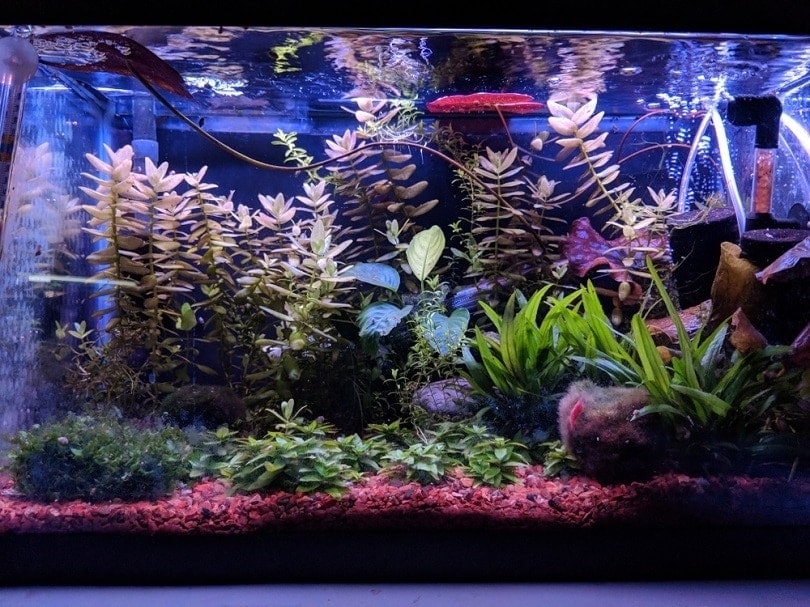

Focal Points
Focal points keep your layout from becoming too busy or distracting. In most cases, less is more. In many aquascaping styles, focal points are naturally created by following the style’s guidelines.
The Iwagumi style, for example, uses multiple stones placed in a certain pattern, with a central stone placed on one of the tank’s third lines. This (by design) creates a focal point according to the Rule of Thirds.
When it comes to your hardscape, don’t add but take away, which ensures that your tank has a striking visual aspect and guides the viewer’s eye across your tank.
Focal points can be created through the effective use of plant selection by either color, scale, or texture.
Plant Selection
It’s important to consider the plant’s adult size and coloration. Choose a plant that’s appropriately sized for where you’re placing it. For example, in most cases, you wouldn’t put a stem plant in the foreground since it’s likely to grow so tall that it blocks the view of the tank.
You also wouldn’t put a low-growing, carpeting plant in the back behind your aquascape. There isn’t a point because it will never be seen.
In most cases, however, focal points are created with one easily-used principle…
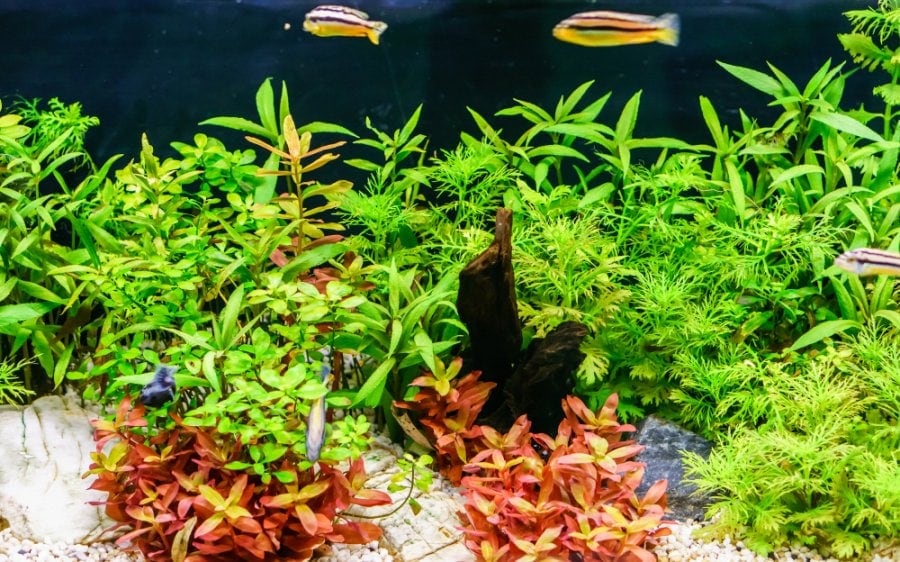

Scale
This is what separates the entries from the winners. Proper scale use in an aquascape makes the “magic.” Again, most of us learn better visually, so here’s a sample layout:
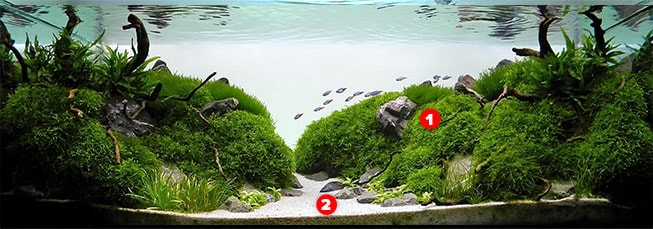
Once again, the Rule of Thirds is very prevalent in this tank. What’s more, you might notice the scale present in this aquascape.
1. Large focal stone(s)
Using larger stones in tanks is a great way to use not just the horizontal space in the aquascape but also the vertical. That’s important, so I’ll repeat it:
Using larger stones makes use of the vertical space in your aquascape. These are what we use.
This is the most common problem in beginner tanks: they’re making relatively good decisions about substrate, plant placement, and fish selection, but their hardscape simply isn’t using the full tank.
The stones or driftwood aren’t large enough to use the open space above the substrate, so everything ends up looking like a low, “squat” layout. If you need pointers on driftwood, perhaps our post on the best aquarium driftwood for sale will help you.
2. Substrate size
Substrate size can play a massive role in the appearance of your tank. That’s why almost all professional Aquascapers use ADA powder-type topsoil. (We recommend this particular type of substrate (see more info at Amazon). The tiny granules lend a greater sense of scale between the hardscape, aquatic plants, and substrate.
If you have the budget to use powder-type, do so. Just remember: it’s a top coat, not a substrate, with which you should create depth.
3. Smaller accent stones
Beginners almost always forget to add small stones. While it’s sometimes hard to find them (sellers only include the large/medium stones), it’s essential to incorporate them to create variance in your hardscape.
It’s essential in hardscapes to think as if they’re in nature: large stones aren’t by themselves. There are almost always a few smaller stones around them that have either chipped off or been pushed up next to them. The same should be true of your Aquascape: place smaller stones naturally in the tank to create a natural look.

Contrast
This is a subtle principle, and it’s not always used in many of the Aquascaping Tanks you’ll find on Aquatic Gardeners. The basic premise of this principle is this:
If everything is emphasized, nothing is emphasized.
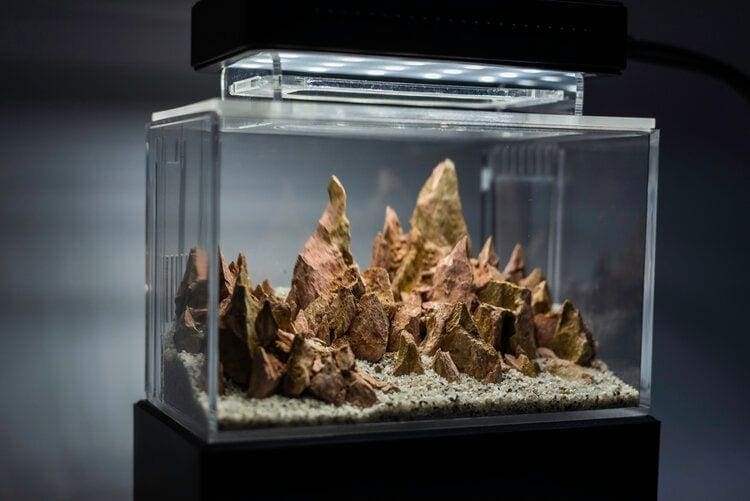
This basically means that if you add a lot of variation to your aquatic plants, substrates, and hardscapes, it will create a busy tank with too much contrast.
However, choose two aquatic plants that differ significantly (in color, for example), a one-color substrate, and one stone type, and you’ll have the beginnings of a great tank.
The green box
If your tank has almost no contrast, it becomes a ‘green box’ to most viewers. (A box with some green, underwater plants.)
The easiest way to avoid this is to use all the aspects of your tank (the substrate, hardscape, and aquatic plants) to show differences between your chosen materials. If you have lots of green plants that grow quickly, choose one vivid red plant (like this Dark Red Ludwigia Plant) to be placed next to your focal point.

Different Styles of Aquascaping
What is really cool about aquascaping is that there are several styles. You can make ones that look like natural forests, jungles, biotopes, and so much more.
Let’s take a look at the most popular types of aquascapes.
Iwagumi Aquascaping
[su_youtube url=”https://www.youtube.com/watch?v=EvMhm0sPvws”]
This type of aquascaping is popular among aquarium enthusiasts. As you might be able to tell by its name, it is a Japanese style of aquascaping.
The defining feature of this aquascape is that stones and rocks are the only items used as hardscapes. In other words, the aquarists will use rocks and stones to form mountains and large rock formations.
Iwagumi aquascaping also usually involves aquatic plants that will carpet the bottom of the tank and grow on the rocks. It’s all about forming a mountainous landscape.
Dutch Aquascaping
[su_youtube url=”https://www.youtube.com/watch?v=EFsoiCG5uiI”]
The most important thing to note is that Dutch aquascaping is the first and oldest type. The defining feature of Dutch aquascapes is the very high density of plant life. The focus is on the fast and widespread growth of fairly large plants and how they are arranged.
The main point of a Dutch aquascape is to have an aquarium with a dense population of plant life. Moreover, the plants should all be quite colorful and form great color contrasts.
This might be the most plant-heavy aquascape, not to mention one of the most colorful ones. It’s a good aquascape for beginners.
Nature Aquascaping
[su_youtube url=”https://www.youtube.com/watch?v=c5oXZDMSqaU”]
Nature aquascaping is another fairly old one, and we must say it looks quite beautiful. It recreates a natural setting, and in this case, it usually takes the form of a forest or grassy landscape.
This is another very plant-heavy type of aquascape. However, unlike Dutch aquascaping, which is purely about plants, nature aquascaping should also involve driftwood, rocks, and caves, thus making it look like something that could occur in nature.
This type of aquascape tends to feature the color green more than anything else.
Jungle Aquascaping
[su_youtube url=”https://www.youtube.com/watch?v=vD4fl2TrxDI”]
Most people would say that jungle aquascaping is like a mix of nature and Dutch styles. Here, you will find a combination of aquatic plants, rocks, and driftwood, although the jungle aquascape has more plants and fewer rocks and driftwood.
Imagine the types of plants you would find in a jungle or a tropical rainforest. Jungle aquascaping is somehow wild and untamed while simultaneously organized and beautiful.
Biotope Aquascaping
[su_youtube url=”https://www.youtube.com/watch?v=tDYauILpENw”]
This might be the coolest type of aquascape because it lets you recreate a natural setting in the wild. Many people who make biotope aquascapes will use nature photos to recreate a natural scene down to the exact detail.
Biotope aquascaping can be a mountain landscape, a desert, a canyon, a jungle, a grassy field, a forest, or anything in between.

FAQs
How Long Does an Aquascape Last?
When you are learning aquascaping, you might hear some people saying that aquascapes only last a certain amount of time. However, an aquascape will last as long as you decide to maintain it.
As long as you supplement your water with nutrients for the aquatic plants, ensure the fish are well-fed and healthy, and have a great aquarium filter, you can keep an aquascape going for as long as you choose. The ball is in your court.
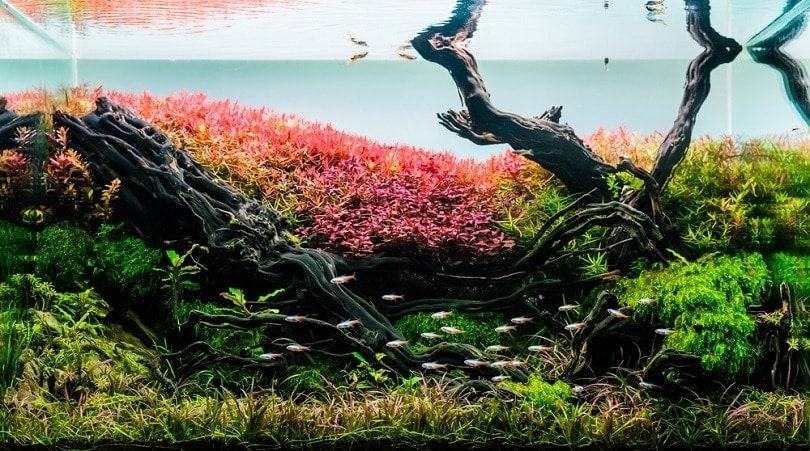
How to Become a Professional Aquascaper?
Quite honestly, aquascaping requires trial and error. Yes, you can come to us for advice and tips, look online, and talk to your local fish-keeping community, too.
There are many places where you can become a pro aquascaper. A good idea is to start with an aquascaping starter kit, which comes with everything you need to get started. Then, it helps to ask experienced aquascapers for advice. You can join online forums and talk to experts who work with aquariums.
Where Can I Get Some Good Aquascaping Ideas for Beginners?
There are many great places to get aquascaping tips and ideas. You can go to YouTube, buy books, check out forums, visit pet stores, and so much more.
[su_youtube url=”https://www.youtube.com/watch?v=GBg5Ana5EZg”]

What Do You Recommend as an Aquascape Starter Kit?
You’ll need essential tools and items to create your own aquascape.
Whether you buy an all-in-one starter kit for aquascapes or create your own from scratch, here are the most important items that you will need (aside from, of course, plants!).
1. A Tank
Yes, the first thing you will need for aquascaping is a good tank. Whether you choose glass or acrylic as the tank material is up to you. Although acrylic may be a bit tougher, it does not look as nice as glass.
The size is also up to you, but to make a good aquascape, you need at least a 20-gallon tank.
2. An Aquarium Filter
Due to their high concentration of plants and often fish, aquascapes are sensitive to debris, waste, rotting plant matter, and organic compounds in the water.
Therefore, you need a top-notch filtration unit that can perform chemical, biological, and mechanical filtration.
3. A Protein Skimmer
A protein skimmer can also be very helpful for an aquascape, as it removes debris and organic compounds from the water. It helps take some of the load off the filter and is especially important if you create a saltwater aquascape.
4. An Air Stone
You may want to consider adding an air pump and an air stone. This is important because to really thrive, your plants and fish will require lots of oxygen.
5. Nutrients & CO2
If you are creating a heavily planted aquascape, you will also want to consider adding nutrients and CO2 to the tank, as both will help keep plants healthy and growing.

What Is a Nano Aquascape?
A nano aquascape is a miniature aquascape, or in other words, an aquascape made inside of a tiny tank. A nano tank is usually less than 5 gallons in size.
[su_youtube url=”https://www.youtube.com/watch?v=UYZN1B4_414″]
How Do You Maintain an Aquascape Tank?
In all fairness, aquascape tanks are not the easiest to maintain.
Here are some of the best tips to follow in terms of aquascape maintenance.
[su_box title=”” box_color=”#393ac4″ radius=”0″][su_list icon=”icon: star” icon_color=”#393ac4″]
- Always keep your filter running and clean. This involves regularly cleaning the filter and changing the media as required. You want as much waste removed from the water as humanly possible.
- Another part of maintaining your aquascape is water changes and cleaning. You want to perform regular water changes, vacuum sand and gravel, use algae scrubbers, and do anything else you can think of to keep the environment clean.
- To make your plants in the aquascape pop, you should probably inject the water with CO2 and add nutrients.
- Regular trimming and pruning of the aquascape plants is also a good idea. To keep things looking great, you must ensure that your plants don’t grow too large or out of shape, as this will ruin the aesthetic appeal of the scene.
[/su_list][/su_box]
Which Fish & Invertebrates Work Well for Aquascape Tanks?
For the most part, aquascape tanks are not large. Of course, you can choose to make your aquascape as big as you please, but for the most part, they are usually relatively compact.
Therefore, most people will stick with smaller fish when choosing the right fish for aquascapes. At the same time, aquascapes are supposed to look beautiful, so having very colorful fish doesn’t hurt either.
So, what are some of the best fish to put in your aquascape aquarium?
[su_row][su_column size=”1/2″][su_box title=”” box_color=”#393ac4″ radius=”0″][su_list icon=”icon: star” icon_color=”#393ac4″]
- Rainbows
- Dwarf Gouramis
- Angel Fish
- Chili Rasboras
- Mosquito Rasboras
- Guppies
- Discus Fish
- Harlequin Rasboras
- Cardinal Tetras
[/su_list][/su_box][/su_column][su_column size=”1/2″][su_box title=”” box_color=”#393ac4″ radius=”0″][su_list icon=”icon: star” icon_color=”#393ac4″]
- Neon Tetras
- Black Neon Tetras
- Ember Tetras
- Danios
- Mollies
- Platies
- Swordtails
- Killifish
- Dwarf Catfish
[/su_list][/su_box][/su_column][/su_row]
A few invertebrates also work well for aquascape tanks, including the following:
[su_box title=”Best Invertebrates” box_color=”#393ac4″ radius=”0″][su_list icon=”icon: star” icon_color=”#393ac4″]
- Assassin Snails
- Nerite Snails
- Bumblebee Shrimp
- Cherry Shrimp
- Ghost Shrimp
- Amano Shrimp
[/su_list][/su_box]
Aquascape Tutorial For Beginners
Here is a good tutorial video to help get you started;
[su_youtube url=”https://www.youtube.com/watch?v=UYZN1B4_414″]

The 9 Design Ideas for Aquascaping Your Aquarium
1. Go Rimless
There’s a reason that professional aquascapes use rimless aquariums to showcase their works of living art. Frames are distracting, dated, and unattractive. You will be floored at the difference a rimless aquarium makes in your aquascape.
Instead of an eyesore, your tank becomes a blank canvas for what you want to design.
[su_youtube url=”https://youtu.be/9zi-Wn5nKi8″]
2. Use Clear Pipes and Clear Tubes for Your Canister Filter
Hiding those unsightly, intrusive black or gray filter pipes in your aquarium can be impossible. Switching out the typical tacky plastic filter pipes for nearly invisible glass makes a significant difference.
Here’s where you can get the glass pipes and clear tubes with the fastest shipping.
Bonus tip:
Place the pipes and their connected tubes on the side of the aquarium near the back (so you don’t notice anything as you look inside the tank face-on), and use transparent suction cups to prop your lily pipe up a bit higher (level with the surface) so there’s more oxygen exchange for your fish.
3. Plants for a Natural Flair
Goldfish can be little lawnmowers in a well-planned aquascape, especially if the plants aren’t carefully chosen. Sure, a hardscape-only tank can look stunning. However, goldfish appreciate having plants as part of their environment, both for shelter and as a natural enhancement to their environment in captivity.
The key is to choose only goldfish-proof plants for your aquascape or ones that grow so fast that it won’t matter if some get eaten. You can place taller plants in the background and lower ones toward the front to create depth.
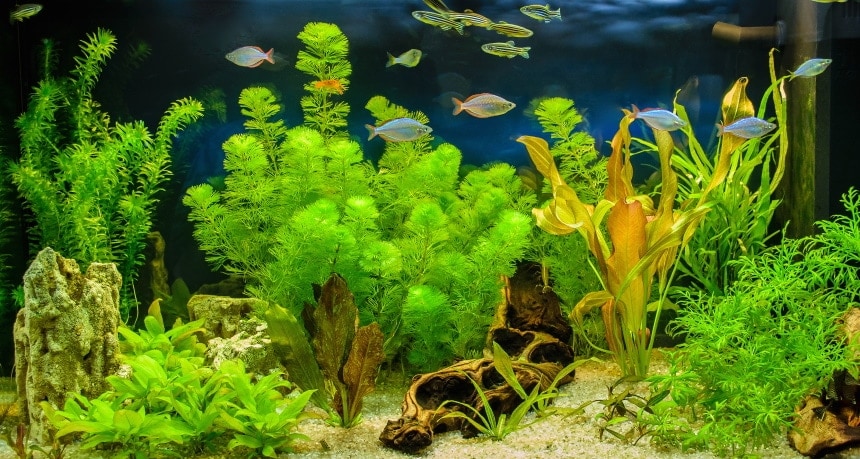
4. Sand is Your Friend
When choosing the substrate for your goldfish tank aquascape, sand is ideal. But if you want to go for a lushly planted tank, be sure you get the kind that provides nutrients to your plants (we highly recommend Seachem Flourite Black Sand). This will look great and help you get ahead of the game with critical elements like iron.
You can also use Caribsea Supernaturals’ “Crystal River,” which is lighter and more beautiful for a tank with rocks and low-maintenance plants like Hornwort and Anubias. So, what you choose depends on your flora.
5. Hide that Heater
If you dislike the look of standard heaters, you can use external heaters connected to a canister filter. If you have a solid desk or cabinet-type aquarium stand, your equipment will remain in the unseen black depths where it belongs.
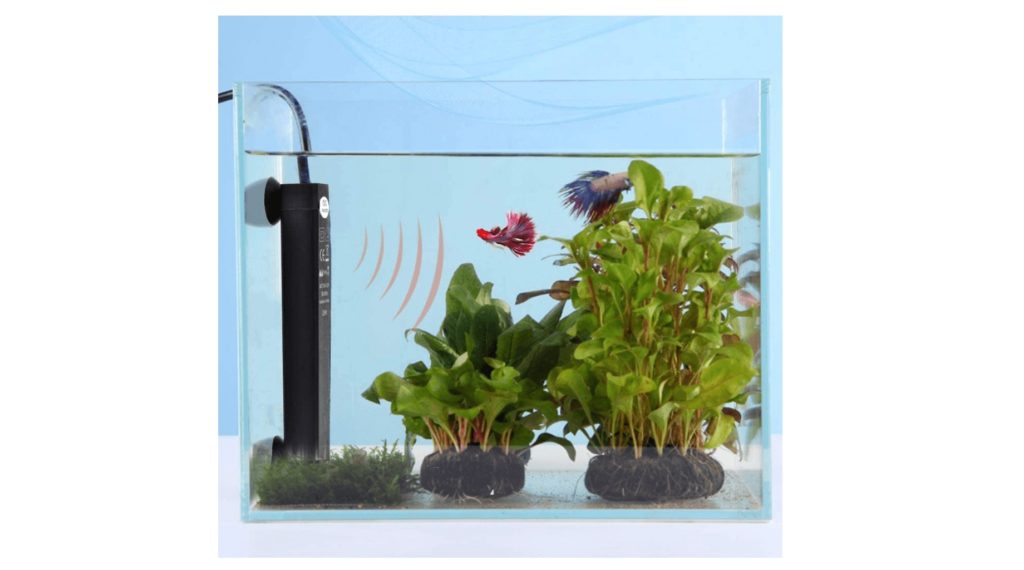
6. Light it Up
Don’t be afraid to use a bright light for your goldfish tank. Not only does it bring a touch of vivacity to the tank, but it also makes your plants happier. Although too much light can lead to algae growth, if you have a good ratio of plants to fish and the water is balanced, the algae should be out-competed over time (or may never even surface).
Each situation is unique, and sometimes, due to the composition of the water and nutrient load, algae may still appear. So, you may want to keep an algae scrubber on hand.
And don’t forget a snail cleanup crew! Snails eat algae and break down waste in the tank, making it more bioavailable to your plants.
7. Be Bold, Be Backless!
With a rimless aquarium, you can go all-out minimalist. It is less of a hassle and looks fantastic. If the tank has a back (most don’t, and it’s often the ones that already have black trim along all edges), keep it solid black.
[su_youtube url=”https://youtu.be/Fy5tEdmxCLc”]
8. Lids and Hoods Off
Having a lid has its perks. It prevents evaporation and can protect an athletic fish like a Common or Comet from jumping out. On the other hand, unless your light sits flush against the hood, you may have trouble with a glare reflecting off of a glass or plastic lid. You must remove it every time you want to change the water. So, it may be worth it to keep the lid off.
(Those intrusive black hoods should be banned.)
9. Integrate a Goldfish-Safe Hardscape
Beware of poky sticks and driftwood. Smooth, fish-safe rocks are ideal. Don’t use all the same-size rocks—break it up with big, medium, and small stones if you want the aquascape to look natural.
Also, the rule of thirds is to avoid placing objects in the “mathematical middle.” This rule can be broken, but it takes a really talented aquascaper to pull it off. Instead, putting large hardscape objects off to one side using the rule of thirds is recommended.
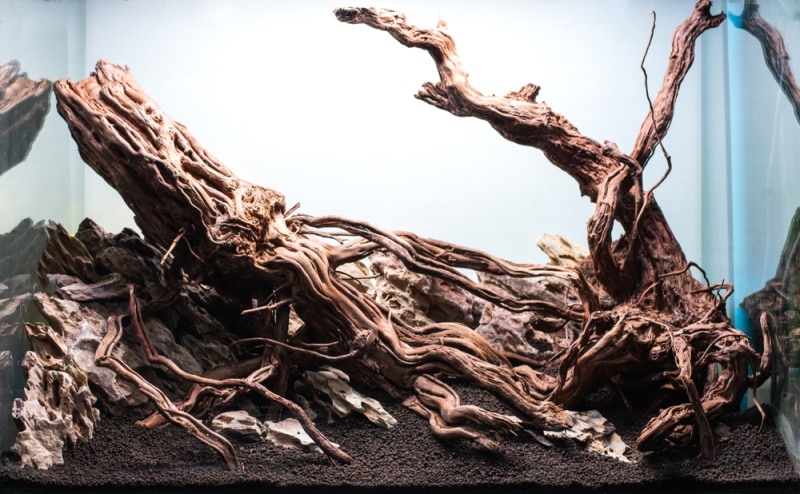

Your Aquascape
Designing an aquascape requires plenty of planning and research, but your hard work will pay off, and you’ll love the results. This article should help you design a stunning aquascape, but you can also talk to experienced aquarists and join online forums for valuable tips. We hope your aquascape amazes your friends and family and keeps your marine life happy!
You Might Be Interested In:
Featured Image Credit: susemeyer0815, Pixabay










